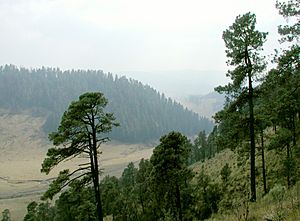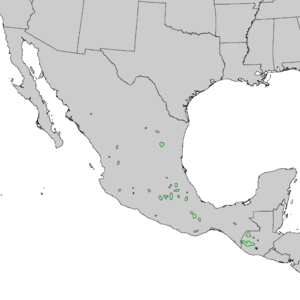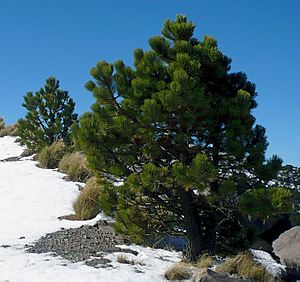Pinus hartwegii facts for kids
Quick facts for kids Pinus hartwegii |
|
|---|---|
 |
|
| Hartweg's pines in Marquesa National Forest, between Mexico City and Toluca, Mexico, at about 3,500 m elevation | |
| Conservation status | |
| Scientific classification | |
| Genus: |
Pinus
|
| Species: |
hartwegii
|
 |
|
| Native range | |
Pinus hartwegii, also known as Hartweg's pine or the Mexican mountain pine, is a special type of pine tree. Its scientific name is Pinus hartwegii, but it's also been called P. rudis or P. donnell-smithii. This tree grows high up in the mountains of Mexico and Central America, reaching as far east as Honduras. It was named after Karl Theodor Hartweg, who first described it in 1838.
Where Hartweg's Pine Lives
Hartweg's pine is a tree that loves high places. It grows at elevations from 2,500 to 4,300 meters (about 8,200 to 14,100 feet) above sea level. This makes it one of the highest-growing pines!
It often forms the alpine tree line on most of Mexico's tallest mountains. The tree line is the highest point on a mountain where trees can still grow. Beyond this line, it's too cold and windy for trees to survive.
You can find this pine in the Sierra Madre Occidental and Sierra Madre Oriental mountain ranges. Its range stretches from Chihuahua and Nuevo León in Mexico down to the highest peaks near the El Salvador—Honduras border. In some areas, like the Sierra Madre Occidental, it experiences very dry winters and heavy summer rains. It also faces constant frosts from October to March.
What's really cool about Hartweg's pine is that it doesn't get small and twisted like many other trees that grow at high elevations. Even at the very cold and windy alpine tree line, this tree stays strong and tall. Scientists study Pinus hartwegii to understand how it can adapt so well to such harsh, cold, and icy conditions.

What Hartweg's Pine Looks Like
Hartweg's pine is an evergreen tree, meaning it keeps its leaves all year round. It can grow quite tall, reaching between 20 and 30 meters (about 65 to 100 feet) in height. It has a wide, rounded top, called a crown.
Its bark is thick and dark grey-brown. It can be scaly or have deep cracks. The leaves are like long needles and are a dark green color. They usually grow in bundles of five, but sometimes four. Each needle is about 10 to 20 centimeters (4 to 8 inches) long and about 1.2 to 1.5 millimeters thick. The base of the bundle has a sheath that stays on the tree, about 1.5 to 2 centimeters long.
Cones and Seeds
The cones of Hartweg's pine are shaped like an egg. They are 6 to 13 centimeters (2.4 to 5 inches) long and are black or a very dark purple color. When they are ready, they open up in the spring to become 5 to 7 centimeters wide.
The seeds inside the cones have wings, which help them fly away in the wind. Each seed is about 5 to 6 millimeters long, and its wing is about 1.5 to 2.5 centimeters long. Pollination, which is how the tree reproduces, happens in the late spring. The cones then take about 20 to 22 months to fully mature.
Hartweg's pine is closely related to the Montezuma pine (Pinus montezumae). You can tell them apart because Hartweg's pine has shorter leaves and its cones are black and smaller, not brown. Where these two types of pines meet at middle elevations, they often hybridize, meaning they can mix and create new trees with features from both parents.
See also
 In Spanish: Ocote blanco para niños
In Spanish: Ocote blanco para niños


